77 Thirty Fifth Street TLAB decision warrants a close read: ‘From a planning perspective, it is not desirable nor appropriate to allow a development at the expense of damage (if not removal) of two mature trees that are not on the Subject Property’
We no longer live in Long Branch, having moved to Stratford in October 2018.
What we learned and experienced during our years in Long Branch has inspired us tremendously.
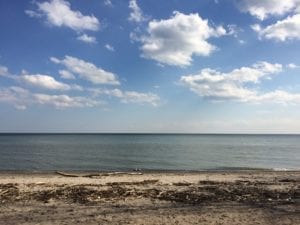
Beach at Marie Curtis Park in Long Branch. The view is from a location west of corner of Lake Promenade and Forty Second Street. Jaan Pill photo.
We continue to be inspired, as well, by the ongoing work of the Long Branch Neighbourhood Association.
One of my connections to Long Branch is now through the Humber College fitness centre.
I look forward to a time when the fitness facility will again be open to Community Members.
My connection to Long Branch is also now through the many things that I have learned about community self-organizing.
I refer, in this context, to a learning process that began long before I lived in Long Branch, but which has vastly been built upon from 1997 to 2018, when I lived in this neighbourhood situated, at the Lake Ontario shoreline, at the Toronto-Mississauga border.
I like to visit Toronto regularly. It’s one way among many that a person can charge up their batteries, so to speak.
Community self-organizing
Successful community self-organizing, in my anecdotal experience, involves work by individuals with specified strengths in specified areas. Such organizing benefits from steps to ensure that all members have a sense of ownership, of the community organizations to which they belong.
It also involves a focus, ideally right from the start, on a culture of leadership succession, which continuously encourages the younger members, over time, to take on the key leadership roles.
In that way you have constant renewal, as opposed to an otherwise inevitable downhill progression, driven by processes of entropy (gradual decline), with the passage of the years.
Such a model of organizing is built upon collaboration, coordination, and a focus on the active promotion of inclusiveness, which serves as a key ingredient in a flat-hierarchy approach to decision making, governance, and information dissemination.
In the context of resourceful work at the community level, a July 31, 2020 Toronto Local Appeal Body (TLAB) decision regarding 77 Thirty Fifth Street in Long Branch warrants a close read.
The narrative concerns many people working together to protect and enhance the tree canopy of Long Branch.
An excerpt reads:
From a planning perspective, it is not desirable nor appropriate to allow a development at the expense of damage (if not removal) of two mature trees that are not on the Subject Property.
You can access the original decision here: 77 Thirty Fifth Street.
In the event any of the formatting of the following text gives rise to confusion, please refer to the original document, which is accessible at the link at the previous paragraph.
July 31, 2020 TLAB decision regarding 77 Thirty Fifth Street
By way of bringing attention to the decision, the current post is dedicated to its contents.
Toronto Local Appeal Body
40 Orchard View Blvd., Suite 211
Toronto, Ontario M4R 1B9
Telephone: 416-392-4697
Fax: 416-696-4307
Email: tlab@toronto.ca
Website: www.toronto.ca/tlab
DECISION AND ORDER
Decision Issue Date: Friday, July 31, 2020
PROCEEDING COMMENCED UNDER Section 53, subsection 53(19), and Section 45(12), subsection 45(1) of the Planning Act, R.S.O. 1990, c. P.13, as amended (the “Act”)
Appellant(s): PAUL ACCADIA
Applicant: VAN ELSLANDER AND ASSOCIATES ARCHITECTS
Property Address/Description: 77 THIRTY FIFTH ST
Committee of Adjustment Case File: 18 249037 WET 06 CO, 18 249038 WET 06 MV, 18 249039 WET 06 MV
TLAB Case File Number: 19 119639 S53 03 TLAB, 19 119640 S45 03 TLAB, 19 119641 S45 03 TLAB
Hearing date: Tuesday, July 09, 2019
DECISION DELIVERED BY SHAHEYNOOR TALUKDER
APPEARANCES
Van Elslander & Associates Architects: Applicant
Kelsey Morrison: Owner
Scott Morrison: Primary Owner/Party [Represented by:] Jason Park of Devine Park LLP
Paul Accadia: Appellant
Don Morrison: Party [Represented by:] Jason Park of Devine Park LLP
Long Branch Neighbourhood Assoc.: Party
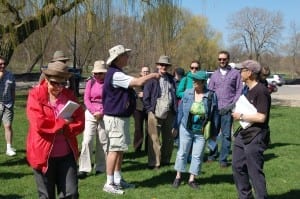
Jane’s Walk in Long Branch, May 2013. The conversation begins at Marie Curtis Park. Gay Chisholm photo
[The following individuals are listed as Participants:]
Ruth Grier
Lola Marcocchio
Zbigniew Blasczyk
Anna Blaszczyk
Jenny Ribeiro
Daryle Moffatt
Alexander Donald
Elaine Billio
Roberta Jordan
Robert Davis
Mary Mccoll
Ruth Weiner
Mark Koczij
Deitre Courchesne
Michael Kohn
Tanya Norman
Debbie Nolan
Veronik Cleary
Donna Donald
Eduardo Pereira
Stephanie Chris
Jim Mosher
Kathy Santaana
Sheila Carmichael
Carla Ursini
Steven Vella
Irina Lipskaya
Chau Duong
George Nikou
Heather Koczij
Matthew Cleary
Mary Peckitt
Phillip Schumacher
Dorothy-Anna Orser
John Macdonald
Anton Braic
Denise Hebert
Deardree Hogan
Elaine Elue
Heather Lebeau
John Cheung
Julia Jordan Ray
Josee Quenelle
Joyce Wheller
Kevin Biss
Kateryna Husband
Lisa Cormier
Elizabeth Edwards
Laurel Fynes
Susan Willsher
Theresa Cook
Christine Mercado
Charlotte Sheasby-Coleman
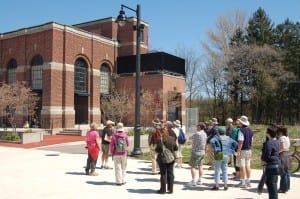
Humber College now has a campus at the Lakeshore Hospital Grounds in New Toronto, just east of Long Branch. The photo is from the May 2013 Long Branch Jane’s Walk. Gay Chisholm photo
INTRODUCTION
1. The appellant, Paul Accadia, appeals the decisions of the Committee of Adjustment (CoA) that approved the Applicant’s applications for consent and variances with respect to 77 Thirty Fifth Street (Subject Property). The Appellant is the owner of the property at 81 Thirty Fifth Street, which is adjacent to the Subject Property. The Long Branch Neighbourhood Association (LBNA) was present at the hearing as a party.
2. The Subject Property is located in the Long Branch neighbourhood.
3. The hearing for this matter took five days and included written closing submissions.
MATTERS IN ISSUE
4. At issue is whether the Toronto Local Appeal Body (TLAB) should approve the applications for consent to sever and variances, subject to proposed conditions. The variances requested are attached to this decision as Attachment 1 and the proposed conditions of consent and variance are attached as Attachment 2.
JURISDICTION
Provincial Policy – S. 3
5. A decision of the TLAB must be consistent with the 2014 Provincial Policy Statement (PPS) and conform to the Growth Plan for the Greater Golden Horseshoe for the subject area (Growth Plan).
Consent – S. 53
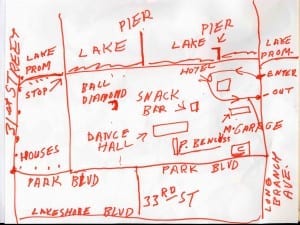
Long Branch Hotel map. Drawing courtesy of Bill Rawson, May 2013
6. TLAB must be satisfied that a plan of subdivision is not necessary for the orderly development of the municipality pursuant to s. 53(1) of the Act and that the application for consent to sever meets the criteria set out in s. 51(24) of the Act. These criteria require that “regard shall be had, among other matters, to the health, safety, convenience, accessibility for persons with disabilities and welfare of the present and future inhabitants of the municipality and to,
(a) the effect of development of the proposed subdivision on matters of provincial interest as referred to in section 2 of the Planning Act;
(b) whether the proposed subdivision is premature or in the public interest;
(c) whether the plan conforms to the official plan and adjacent plans of subdivision, if any;
(d) the suitability of the land for the purposes for which it is to be subdivided;
(d.1) if any affordable housing units are being proposed, the suitability of the proposed units for affordable housing;
(e) the number, width, location and proposed grades and elevations of highways, and the adequacy of them, and the highways linking the highways in the proposed subdivision with the established highway system in the vicinity and the adequacy of them;
(f) the dimensions and shapes of the proposed lots;
(g) the restrictions or proposed restrictions, if any, on the land proposed to be subdivided or the buildings and structures proposed to be erected on it and the restrictions, if any, on adjoining land;
(h) conservation of natural resources and flood control;
(i) the adequacy of utilities and municipal services;
(j) the adequacy of school sites;
(k) the area of land, if any, within the proposed subdivision that, exclusive of highways, is to be conveyed or dedicated for public purposes;
(l) the extent to which the plan’s design optimizes the available supply, means of supplying, efficient use and conservation of energy; and
(m) the interrelationship between the design of the proposed plan of subdivision and site plan control matters relating to any development on the land, if the land is also located within a site plan control area designated under subsection 41 (2) of this Act or subsection 114 (2) of the City of Toronto Act, 2006. 1994, c. 23, s. 30; 2001, c. 32, s. 31 (2); 2006, c. 23, s. 22 (3, 4); 2016, c. 25, Sched. 4, s. 8 (2).”
Variance – S. 45(1)
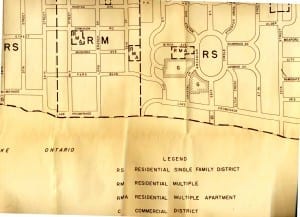
A map from the Long Branch Historical Society shows the shoreline of Lake Ontario as it existed during the years before the Long Branch Hotel burned down.
7. In considering the applications for variances from the Zoning By-laws, the TLAB Panel must be satisfied that the applications meet all of the four tests under s. 45(1) of the Act. The tests are whether the variances:
• maintain the general intent and purpose of the Official Plan;
• maintain the general intent and purpose of the Zoning By-laws;
• are desirable for the appropriate development or use of the land; and
• are minor.
EVIDENCE
8. At the hearing, there was oral testimony of several expert witnesses and witnesses. Neighbours Tanya Norman and Elizabeth Edwards also testified as participants. While I have considered all the testimony, I have summarized below the portions of the evidence that is relevant in making my decision.
9. The Applicant called Jordan Kemp, a professional Land Use Planner, who was qualified at the hearing as an expert in land use planning.
10.Mr. Kemp testified that the two proposed lots will not be of the same size. The north lot will have an area of 270 m2 with lot frontage of 8.9m and the south lot will have an area of 221.9 m2 with lot frontage of 7.25 m. The frontages are different to accommodate the preservation of trees. The north lot is wider with a series of step backs at the rear of the property to allow for preservation of two trees on 81 Thirty Fifth Street (Appellant’s property) as well as the Norway Maple tree which is a boundary tree on the Applicant’s and Appellant’s properties.
11.Mr. Kemp testified that the proposed buildings are designed to complement the features of the immediate neighbourhood. Each proposed dwelling will require four variances (as listed in Attachment 1). The building envelope of each building does not require any variances with respect to height, length or setbacks. The height of the second floor is lower than the zoning by-law limit to complement the houses on the north and south of the Subject Property. Similarly, the proposed depth, scale and massing of the buildings will complement the adjacent dwellings. As a result of these features, the proposal is in keeping with the recommended Long Branch Neighbourhood Character Guidelines (Long Branch Guideline).
12.Both buildings will have integral garages, small front porches and ground floor decks. The north dwelling will not have any windows on the wall facing the adjacent property at 81 Thirty Fifth Street. There will be two narrow vertical windows on the northern main wall of the stepped back portions on the ground floor and second floor. For the south dwelling, the south facing wall will not have any windows on the main floor. There will be a window on the second floor and a narrow deck from one of the bedrooms on the second floor. The design of the dwellings will allow for the neighbours’ privacy.
13.Mr. Kemp established two study areas, a broader neighbourhood area (Study Area) and an immediate geographic area adjacent to the Subject Property (Focused Study Area). He noted that the Subject Property is located in the Long Branch neighbourhood, which is adequately served by public transit. The Study Area includes the Subject Property generally in the centre and is bounded by Lake Shore Boulevard West to the north, Forty Second Street to the West, Lake Promenade to the south and Twenty Third Street to the east. The Focused Study Area is enclosed in the Study Area and is bounded by Thirty Sixth Street to the west, the north side of Lake Promenade and the north side of Park Avenue in the south, Thirty Third Street in the east and rear of properties fronting the Lake Shore Boulevard West in the north.
14.Mr. Kemp stated that both study areas have two zoning categories, the restrictive Residential Detached (RD) and the more permissive Residential Multiple Zone (RM), which allows for multiple building types. There are a broad range of buildings in the Study Area such as detached and semi-detached dwellings, and apartment buildings. The Focused Study Area has a mix of detached, semi-detached, duplex, triplex and walk-up apartment buildings. These buildings reflect a broad range of architectural styles with predominant dwellings being 2-3 storeys with a variety of roof styles such as gable, hip and flat roofs.
15.Mr. Kemp noted that an important characteristic of the Focused Study Area is that dwelling types, lot fabric and setbacks are not consistent for more than a block, as building types are mixed, resulting in detached dwellings being adjacent to semi-detached or other types of dwellings. This inconsistency in building types and styles is evident along Thirty Fifth Street. The Focused Study Area has examples of semi-detached dwellings on undersized lots – for example, eight semi-detached dwellings on Thirty Fifth Street have a lot frontage between 7.77 m and 8.23 m and others on Thirty Third Street have lot frontages of 6.71 m and 6.91 m. The Subject Property, and the two adjacent properties at 75 and 81 Thirty Fifth Street, are the only detached dwellings on the surrounding block. Directly across the Subject Property to the west is an apartment building complex with a park.
16.Mr. Kemp opined that the proposal satisfied the four tests for variance. He noted that the Subject Site is designated as Neighbourhoods under the OP. With respect to OP 4.1.5 (as amended by OPA 320), he noted that there is no prevailing character in the context of the immediate streetscape or the Focused Study Area. He opined that the requested lot frontage respected and reinforced the varied lot frontages in the immediate area, which did not have any consistent lot frontages. He noted that one quarter of the existing lots in Thirty Fifth Street has frontages less than the requested frontage. The lot frontages are different for the two lots to accommodate the existing mature trees on and surrounding the property to help preserve the tree canopy as per the Long Branch Guideline. He noted that the reduced lot area is an outcome of the shallow lot depth of 30.49 m and will not be observable from the street or adjacent properties. The reduced lot area will still accommodate a building envelope that does not require any variances for height, length and setbacks. The smallest proposed lot is not the smallest in the neighbourhood as there are other lots in the area which are smaller. He noted that OP 3.4.1(d) is also satisfied based upon the planning opinion that the Applicant has made significant efforts to preserve the trees and roots of adjacent properties.
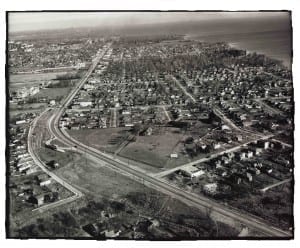
Aerial view (November 1949) looking east along Lake Shore Blvd West from near Long Branch Loop, Ontario Archives Acc 16215, ES1-814, Northway Gestalt Collection. The photo shows the Colonel Samuel Smith house at Forty First St. and Lake Shore Blvd. West, originally a log cabin built in 1797, to which extensions and siding were added over the years. Click on image to enlarge it.
17.Mr. Kemp noted that density is an outcome of the proposed built form which should fit and be compatible with the physical characteristics of the neighbourhood. He opined that the requested variances for FSI have modest increases and are within the range of permitted densities in the area. Each proposed dwelling is appropriately massed and scaled when taken in context with the two adjacent dwellings and the recommended guidelines set out in the Long Branch Guideline. There are properties on 41 Long Branch Avenue and Thirty Third Street with FSI of 0.64 and 0.72. The height, setbacks and length of the buildings are within the zoning by-law parameters and fit within the existing physical context of the area.
18.Mr. Kemp noted that the decks at the back provides a modest outdoor amenity space that does not create any unacceptable impact. The encroachment into the backyard requested by way of variance is modest. Further, the proposed installation of privacy screens (as set out in the conditions for variance in Attachment 2) will decrease any impact on privacy.
19.Mr. Kemp addressed the consent criteria under subsection 51(24) of the Act. He opined that the relevant criteria are met. He stated that the divided lots are of a size and shape suitable to accommodate the proposed semi-detached house which are in keeping with the OP policies. He further noted that the proposed development is specifically designed to accommodate and preserve existing mature trees on the Subject Property and those adjacent to the property.
20.The preservation of trees as an issue was addressed by three expert witnesses – Ms. Laura Watson, a certified Tree Risk Assessor who prepared the Arborist Report and Tree Preservation Plan for the Applicant, Mr. Ian Bruce, an arborist retained by Mr. Accadia and Dr. Max Dida, Urban Forestry Supervisor, at the City of Toronto. Dr. Dida was subpoenaed by Mr. Accadia.
21.Ms. Watson testified that she identified six trees: (1) a city owned Red Oak whose roots extend into the existing sidewalk, (2) a city owned Red Oak in front of the Subject Property, (3) a Manitoba Maple which will be removed because of the poor condition of the tree, (4) a Red Oak on Mr. Accadia’s property, (5) a Norway Maple which is a boundary tree shared by the Subject Property and Mr. Accadia’s property and (6) another Red Oak on Mr. Accadia’s property.
22.Trees 2, 4, 5, and 6 will be affected by the proposed development. Ms. Watson conducted root excavation near the back of the current building near trees 5 and 6 and noted that significant large roots from trees 5 and 6 are present along with few smaller roots. Her tree protection plan included an establishment of a tree protection zone, removal of patio stone in the back of the current building, a bar on using heavy machinery, and hand excavation, etc. Tree 6 will also require removal of overhanging limbs to facilitate the construction. For the Red Oak (tree 2) on the city boulevard, similar methods are to be used including proposal of using a GeoWeb driveway, which is less detrimental than construction of the traditional driveway. In Ms. Watson’s opinion, tree 4 will not be impacted with the establishment of a tree protection zone. The other trees (2, 5 and 6) would require a permit to injure but removal of these trees would not be necessary based on her tree protection plan, which shows a small level of impact.
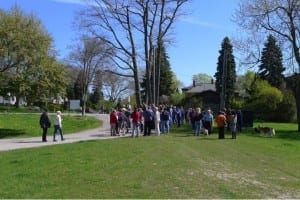
Long Branch Jane’s Walk, May 6, 2012. We began the walk at Marie Curtis Park at the mouth of Etobicoke Creek. Peter Foley photo
23.Dr. Dida did not agree with Ms. Watson’s assessment. His office opposed the consent and variance applications. Dr. Dida opined that the trees will suffer injuries that will be detrimental to the extent that they will not survive such injury. He noted that during excavation, it was revealed that the roots are large and development around the area (as per the tree protection plan) will seriously injure the trees. The limb of tree 6 that will be cut is about 20-30 cm in diameter and this injury will not be acceptable when taken into context with the additional impacts of injury near the tree roots. Tree 2 is a large tree with 86 cm in diameter with big roots near the proposed development. This tree will not survive the injuries proposed to the roots. With respect to tree 5, Urban Forestry may agree to issue a permit to injury this tree as the impact of injury was decreased to 2.4% based on the latest arborist report. Dr. Dida appreciated that removal of the patio stones would be beneficial for the trees. During the course of the hearing, Ms. Watson was in some level of communication with Dr. Dida’s office and provided amended arborist reports to Urban Forestry. Dr. Dida’s opinion did not change with respect to tree 2 and tree 6 as he deemed the methods to preserve the trees as being insufficient to protect the trees.
24.Dr. Dida noted that if the proposal is approved by the TLAB, Urban Forestry can deny the permit to injure the trees but will consider permits to remove the trees. If a permit to remove is approved, then the Applicant and Mr. Accadia will need to address removal of tree 6 as a private civil matter.
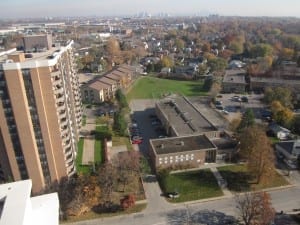
View of Parkview School, subsequently renamed as École élémentaire Micheline-Saint-Cyr, photographed from top of Aquaview Condominiums, November 2012. Photo credit: Jaan Pill
25.Mr. Bruce testified on the quality the trees 4, 5 and 6, which he believed are in good health. Though the exact age of a tree cannot be determined without cutting down the tree, Mr. Bruce estimated that the Norway Maple (tree 5) is about 30 to 40 years old and the Red Oak (tree 6) is about 60 to 80 years old. He noted that cutting down branches of a tree is like cutting down the “food factory” of the tree, but tree 6 will not likely die from the cutting of the tree limb.
26.The Appellant called Dr. Puric-Mladenovic, who was qualified at the hearing as an expert on urban forest conservation and environmental impact. While Dr. Puric-Mladenovic had extensive expertise in urban forest conservation, she did not directly address the proposed development on the Subject Property. She testified on the importance of conservation of trees in a densely populated city as Toronto. She also discussed her current study on tree canopy loss in Long Branch, which she believes is a result of the development in the areas, specifically severance activities. In reviewing her study, she acknowledged that the control group study was not yet completed at the time of the hearing.
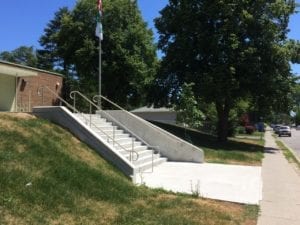
View of new main entrance stairs, one of many new, recently constructed landscape features at École élémentaire Micheline-Saint-Cyr, 85 Forty First St. in Long Branch. Jaan Pill photo.
27.Mr. Godley, qualified as a local area expert for the Long Branch neighbourhood, testified that he opposed the proposed development. He disagreed that the neighbourhood as described by Mr. Kemp is eclectic. He further testified that the flat roof structure of the proposed dwellings does not fit with the adjacent houses that have sloped roofs that [complement] the neighbourhood. He further noted that the mature trees around the Subject Property are a feature of the block where the Subject Property is located and should be enhanced instead of removed.
28.Ms. Stephanie Chris is a participant but was also the representative of the Appellant . She resides at 81 Thirty Fifth Street. She shares the boundary tree 5 with the Applicant and tree 6 is located on her property. She testified that the large mature trees are part of the existing physical character of her neighbourhood. These large trees along with proximity to water makes the neighbourhood attractive. She was very concerned that the cutting of the limb of tree 6 would lead to its death. If the permit to remove is issued by Urban Forestry, she will not agree to such removal.
29.Ms. Tanya Norman, a neighbour to the south of the Subject Property, testified that she enjoyed the tree canopy and the cottage style houses that are part of her neighbourhood. She did not take any issue with construction in the neighbourhood but was concerned with this specific proposal because the splitting of the lot will result in large houses in smaller lots at the expense of damaging the mature trees. Ms. Liz Edwards also testified that she believed that the development of the two houses would be too big for the neighbourhood.
30.Ms. Christine Mercado, chair for the LBNA, testified opposing the proposed development. She noted that LBNA does not oppose intensification and is engaged in having the resident navigate through the process of consent and variance approvals. She noted that the Long Branch neighbourhood have been receiving the greatest number of consent applications along with the Willowdale neighbourhood.
31.Ms. Mercado noted that the Long Branch neighbourhood is one of the oldest neighbourhoods in Toronto. The properties north and south of Lakeshore Blvd. have different characteristics. For example, the properties south of Lakeshore Blvd. have a denser tree canopy.
32.Ms. Mercado described her neighbourhood study area to be the area between Lakeshore Blvd. and Lake Promenade, and bounded by Thirty Third Street at the east and Thirty Seventh Street to the West. She chose this study area because it is what residents would consider to be their neighbourhood – such as walking between two parks, going to school, etc. She noted that this study area has predominantly single-family dwellings followed by tri-plexes. She did not consider properties east of Thirty Third Street because she did not have sufficient data on the small number of lots located at the east. Based on her study area comprising of 407 lots, she noted that about 77% of the lots exceeded the minimum lot frontage and about 78% exceeded the minimum lot area under the zoning by-laws. There are only fourteen semis in the 407 lots. She concluded that the proposed development did not meet the four tests as semi-detached dwellings and the proposed lot frontage and lot area features are not common in the neighbourhood.
ANALYSIS, FINDINGS, REASONS
33.I am satisfied that the applications for consent and variances do not conflict with the PPS and Growth Plan, as these policies are centered on intensification and the requested variances promote intensification and redevelopment of land.
34.The applications for consent and variances are not approved because the Applicant did not satisfy the consent criteria under subsections 51(24) (c), (d), (f), (g) and (h) of the Act. With respect to s. 51(24)(c) and (h), the OP policies 3.1.2(1)(d) and 3.4.1(d) are not satisfied. These sections of the Act and policies relate to the preservation of trees.
35.A significant issue in this application is the outcome of the mature trees if the applications are approved. Based on the testimony on the mature trees, I make the following findings:
a. Tree 2, Red Oak: Dr. Dida testified that this tree is a healthy large tree with a trunk of about 86 cm in diameter. The proximity of the tree to the Subject Property is such that the tree’s important roots will be significantly affected by the construction. I find that the current protection measures proposed by the Applicant will not be sufficient to protect the tree. Urban Forestry will not accept a permit to injure this tree but if TLAB approves the proposal, although it can entertain a permit to remove this tree.
b. Tree 6, Red Oak: Dr. Dida testified that the combination of limb removal and construction near the root will result in serious injury to the tree. I find that the current protection measures proposed by the Applicant will not be sufficient to protect the tree. Urban Forestry will not accept a permit to injure but may allow a permit to remove if the applications are approved by the TLAB. According to Mr. Bruce’s assessment, this tree is about 60 to 80 years old.
36.The Applicant proposes that the architectural design of the semi-detached dwellings along with the tree protection plan will protect the two trees. The Urban Forestry representative disagrees. I have accepted Dr. Dida’s testimony as an indication that approval of the proposed development will result in significant injury to these two mature trees, and if the applications are approved, these trees may need to be removed; a permit to injure will not be granted by Urban Forestry.
37.I find that the shape, size and configuration of the proposed lots are not adequate to permit buildings of sufficient scale to avoid injury to the natural environment features of the Subject Property and the streetscape within which it is located.
38.OP 3.1.2(1)(d) states that new development should take into consideration “preserving existing mature trees wherever possible and incorporating them into landscaping designs.” This qualifier “wherever possible” is not an escape route to avoid preservation of trees in the course of developing properties. Rather, preserving existing mature trees must be considered wherever possible. The Applicant has made significant efforts to accommodate the preservation of the two mature trees. However, the issue under OP 3.1.2(1)(d) is not whether an applicant attempted preservation of the trees; the question is whether the trees can actually be preserved wherever possible. In this case, a city owned tree which is not on the Subject Property but on the street in front of it and another tree which is on the neighbours’ property should not be the subject of significant injury (and removal) because of the proposal for the Subject Property. It is possible that even if the trees are not removed, the injury they will suffer will ultimately lead to their death.
39.I have considered the importance of preservation of the natural environment and enhancement of urban forest set out in OP 3.4.1. I am not satisfied that a development proposal that will result in injury to and removal of mature trees that are situated outside the property to be developed complies with the overall purpose of OP 3.4.1. As such, the Applicant did not establish that the variances requested satisfy the general intent and purpose of the OP.
40.The proposal also does not satisfy that the variance test that this development is desirable or appropriate for the development of the land. The Long Branch neighbourhood is a neighbourhood that is endowed with mature trees. As noted by Ms. Chris and echoed by other witnesses, these form part of the physical characteristics of the neighbourhood. As per Ms. Mercado’s lived experience, the properties south of the Lakeshore Blvd. have a dense tree canopy. The two mature trees are large and contribute to the tree canopy of the neighbourhood. From a planning perspective, it is not desirable nor appropriate to allow a development at the expense of damage (if not removal) of two mature trees that are not on the Subject Property.
41.Finally, I find that the variances, individually and collectively, are intimately connected to the proposed severance. In this circumstance, it does not appear appropriate to address the individual variances further as their respective lot application is not supported.
42.As a result of the foregoing, the applications for consent and variances are not approved.
DECISION AND ORDER
43.The decisions of the Committee of Adjustment are overturned. The approvals of the applications for consent to sever and variance are denied.
Shaheynoor Talukder
Panel Chair, Toronto Local Appeal Body
Signed by: Shaheynoor Talukder
ATTACHMENT 1
Variances
North Lot – Part 2 (A0788/18EYK)
1. Section 900.6.10.(2)(B), By-law 569-2013
The minimum required lot frontage is 10.5 m.
The new lot frontage will be 8.9 m.
2. Section 900.6.10.(2)(A), By-law 569-2013
The minimum required lot area is 325 m².
The new lot area will be 270.35 m²
3. Section 900.6.10.(2)(D), By-law 569-2013
The maximum permitted gross floor area is 0.6 times the area of the lot (133.1 m²).
The proposed dwelling will have a gross floor area equal to 0.62 times the area of the lot (166.5 m²).
4. Section 10.5.40.60.(1)(C), By-law 569-2013
A platform with a floor no higher than the first floor of the building above established grade may encroach into the required rear yard setback 2.5 m, provided it is no closer to a side lot line than 0.3 m.
The proposed platform will encroach 2.93 m into the required rear yard setback.
South Lot – Part 1 (A0789/18EYK)
1. Section 900.6.10.(2)(B), By-law 569-2013
The minimum required lot frontage is 10.5 m.
The new lot frontage will be 7.25 m.
2. Section 900.6.10.(2)(A), By-law 569-2013
The minimum required lot area is 325 m².
The new lot area will be 221.93 m².
3. Section 900.6.10.(2)(D), By-law 569-2013
The maximum permitted gross floor area is 0.6 times the area of the lot (133.1 m²).
The proposed dwelling will have a gross floor area equal to 0.74 times the area of the lot (163.9 m²).
4. Section 10.5.40.60.(1)(C), By-law 569-2013
A platform with a floor no higher than the first floor of the building above established grade may encroach into the required rear yard setback 2.5 m, provided it is no closer to a side lot line than 0.3 m.
The proposed platform will encroach 2.93 m into the required rear yard setback and will be located 0.27 m from the north side lot line.
Attachment 2
Proposed Conditions of Approval
Consent Conditions of Approval
1. Confirmation of payment of outstanding taxes to the satisfaction of Revenue Services Division, Finance Department.
2. Municipal numbers for the subject lots indicated on the applicable Registered Plan of Survey shall be assigned to the satisfaction of Survey and Mapping Services, Engineering Services, Engineering and Construction Services. Contact: John Fligg @ (416) 338-5031 or Elizabeth Machynia @ (416) 338-5029.
3. Prior to the issuance of a building permit, the applicant shall satisfy all conditions concerning City owned trees, to the satisfaction of the Director, Parks, Forestry & Recreation, Urban Forestry Services.
4. Where no street trees exist, the owner shall provide payment in an amount to cover the cost of planting a street tree abutting each new lot created, to the satisfaction of Urban Forestry Services.
5. Two copies of the registered reference plan of survey integrated to NAD 83 CSRS (3 degree Modified Transverse Mercator projection), delineating by separate Parts the lands and their respective areas, shall be filed with the Manager of Land and Property Surveys, Engineering Services, Engineering and Construction Services. Contact: John House, Supervisor, of Property Records, at 416 392-8338; jhouse@toronto.ca.
6. An electronic copy of the registered reference plan of survey satisfying the requirements of the Manager of Land and Property Surveys, Engineering Services, Engineering and Construction Services, shall be filed with the Committee of Adjustment.
7. Within ONE YEAR of the date of the giving of this notice of decision, the applicant shall comply with the above-noted conditions and prepare and submit for electronic submission to the Deputy Secretary-Treasurer, the Certificate of Official, Form 2 or 4, O. Reg. 197/96, referencing either subsection 50(3) or (5) or subsection 53(42) of the Planning Act , as it pertains to the conveyed land and/or consent transaction.
Variance Conditions of Approval
1. The applicant shall comply with the conditions imposed in the Committee of Adjustment’s Consent Decision Number B0084/18EYK.
2. The severed and retained lots shall be developed substantially in accordance with the site plan drawings prepared by Van Elsander and Associates Architects, dated July 2, 2019.
3. Privacy screening shall be placed along the north elevation of the rear yard deck to be constructed on lot 1 and the south elevation of the rear yard deck to be constructed on lot 2. Such privacy screening shall be built to the height permissible pursuant to Zoning By-law No. 569-2013.
4. Submission of a complete application for a permit to injure or remove a City-owned tree(s), as per City of Toronto Municipal Code Chapter 813, Trees Article II Trees on City Streets.
5. Submission of a complete application for a permit to injure or remove a privately owned tree(s), as per City of Toronto Municipal Code Chapter 813, Trees Article III Private Tree Protection.
6. The following conditions shall be fulfilled to the satisfaction of the Engineering and Construction Services Division:
6.1. The applicant must obtain written approvals from Urban Forestry Services for the proposal of the driveway placement adjacent to the existing tree.
The applicant shall submit revised site plan with the following revisions and notations to the satisfaction of the Engineering and Construction Services and Transportation Services, at no cost to the City;
a) Illustrate the existing and proposed grades along the boundary limit and within the proposed site;
b) Revise site plan to illustrate a positive slope of minimum 2% to 4% that will be maintained on each of the proposed driveways, as measured between the proposed garage door entrance to the curb line of Thirty Fifth Street;
c) The site plans must be revised to clearly indicate the restoration of the redundant portion of curb cuts for the former driveway with sod and raised concrete curb, and new curb cuts for the proposed dwellings, all of which shall be designed to municipal standards.
d) Add the following notations to the Site Plan:
i “The applicant is required to restore any redundant section of the existing driveway that is being closed with sod and a poured raised concrete curb within the municipal boulevard according to City of Toronto Design Standard;
ii “The proposed new driveways shall be constructed to the applicable City of Toronto Design Standards at no cost to the municipality”;
iii “The applicant shall also submit a Municipal Road Damage Deposit (MRDD) prior to obtaining a Building Permit.” The applicant is advised to contact Ms. Joanne Vecchiarelli of our Right-of-Way Management Section at (416) 338-1045 regarding municipal road damage deposit requirements; and,
iv “The applicant shall obtain the necessary authorizations and permits from the City’s Right-of-Way Management Section of the Transportation Services before excavating within or encroaching into the municipal road allowance.”
7. The following conditions shall be fulfilled to the satisfaction of Heritage Preservation Services:
7.1. The applicant shall retain a consultant archaeologist, licensed by the Ministry of Tourism, Culture and Sport, under the provisions of the Ontario Heritage Act (R.S.O. 1990 as amended) to carry out a Stage 1- 2 archaeological assessment of the entire development property and follow through on recommendations to mitigate, through preservation or resource removal and documentation, adverse impacts to any significant archaeological resources found. The assessment is to be completed in accordance with the 2011 Standards and Guidelines for Consulting Archaeologists, Ministry of Tourism, Culture and Sport.
7.2. Should the archaeological assessment process continue beyond a Stage 1-2 assessment, any recommendations for Stage 3-4 mitigation strategies must be reviewed and approved by Heritage Preservation Services prior to commencement of the site mitigation.
7.3. The consultant archaeologist shall submit a copy of the relevant assessment report(s) to the Heritage Preservation Services Unit in both hard copy format and as an Acrobat PDF file on compact disk. All archaeological assessment reports will be submitted to the City of Toronto for approval concurrent with their submission to the Ministry of Tourism, Culture and Sport.
7.4. No demolition, construction, grading or other soil disturbances shall take place on the subject property prior to the City’s Planning Division (Heritage Preservation Services Unit) and the Ministry of Tourism, Culture and Sport (Heritage Operations Unit) confirming in writing that all archaeological licensing and technical review requirements have been satisfied.
[End of text]
Land use, space use, and the role of (properly sourced and contextualized) evidence
The broader topic is land use, space use, and the fate of the planet.
An underlying theme, bringing all of these things together, is the value of evidence. I refer in particular to evidence that is gathered using rigorous methodology, and is analyzed within a robust framework.
With regard to land use, a Sept. 13, 2020 Globe and Mail article by Joshua Gordon, an assistant professor in the Simon Fraser University School of Public Policy, warrants a close read, along with the TLAB decision that is the topic of the current post.
The article is entitled: “The ‘supply crisis’ in Canada’s housing market isn’t backed up by the evidence.”
An excerpt reads:
So why is the debate so evidence-averse? Because the narrative is useful to powerful people.
The supply narrative does two things. It helps stymie action on the demand-side, which might actually bring prices and rents down, while giving cover to governments who want to pretend to care about affordability for the middle class. And it is a useful weapon for developers seeking to gain various policy concessions, including rezonings from municipal governments, which deliver windfall land appreciation.
The vested interests behind the narrative are relentless, since there are billions in profit to be had. Why let pesky facts get in the way? Such interests, and their noisy Twitter allies, are trying to win the debate through sheer repetition.
However, housing affordability will suffer to the extent that policy makers either buy into the misdirection, or use the narrative to deflect public pressure to take substantive action. Sometimes, then, it’s helpful to point out that the emperor has no clothes.
A note for followers of this blog
In the next few months, I will post a number of items that I was planning to write, before my attention turned to other matters including ongoing research and interviews, for a book project based on the life and legacy of an Alberta speech therapist and researcher.

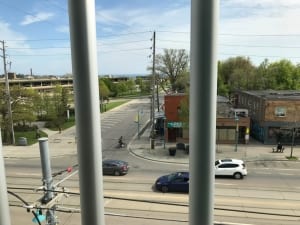
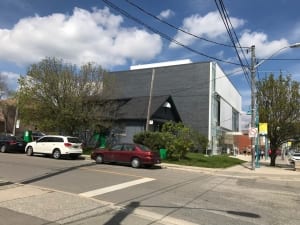

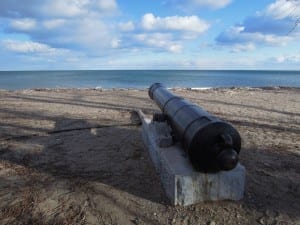
Leave a Reply
Want to join the discussion?Feel free to contribute!